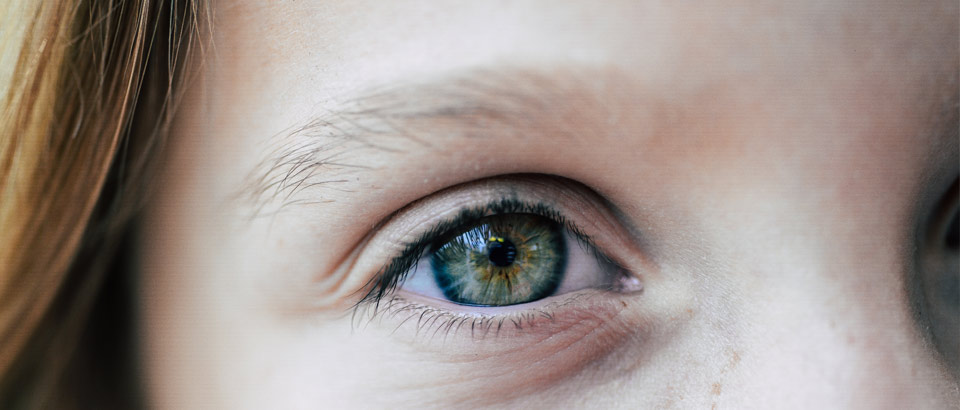August 12, 2024
Pink eye, also known as conjunctivitis, affects both adults and children, with about 3 million cases reported each year in the United States alone.1 While pink eye is one of the most common and treatable eye conditions, it's also incredibly uncomfortable and sometimes just downright gross.
As its name implies, pink eye causes the white of the eye to turn pink or red. The pink or reddish color is a result of the inflammation of the conjunctiva, which is the clear, thin membrane that lines the inside of the eyelid and white portion of the eyeball.
Some of the more ick-inducing symptoms of pink eye include a discharge, pus, or mucus secreting from the eyes, which sometimes causes the eyelashes to stick together. Especially in the morning, you might find you have crusty eyelids or eyelashes. Most people know that pink eye is a highly contagious disease, but that's not actually always the case. It all depends on the type.

How Do You Get Pink Eye?
Did you know that there are four main causes of pink eye? Of the four, only two are actually considered highly contagious: viral and bacterial conjunctivitis. Viral and bacterial conjunctivitis can easily spread from person to person either by direct contact, airborne transmission, or interaction with an infected object.2 This makes schools a prime place for pink eye to be spread: In fact, according to one study, bacterial conjunctivitis is the leading cause of children staying home from daycare or school.3
Contagious Pink Eye Symptoms
Viral conjunctivitis, one form of contagious pink eye, is an infection of the eye that is caused by a wide variety of viruses. It typically begins in one eye and then spreads to the other within days. Discharge from the eye is usually watery rather than thick, and it may occur in combination with an upper respiratory tract infection, cold, or sore throat.1
Bacterial conjunctivitis, the other type of contagious pink eye, is an infection of the eye that is - you guessed it - caused by bacteria. It sometimes occurs with an ear infection, and the discharge associated with this type of pink eye can cause eyelashes to stick together. Bacterial conjunctivitis is much more common in children than adults.2
Non-Contagious Pink Eye Symptoms
While the other two common causes of pink eye – allergens and irritants – are not contagious, they can be just as irritating.
Allergic conjunctivitis is the body's reaction to allergens, including molds, pollen, dust mites, animal dander, and more, and, in most cases, affects both eyes. While discharge isn't normally a symptom, the eyes do tend to become red or pink, swollen, extremely itchy, and watery.
Contact lens wearers are likely the most familiar with the final common cause: irritants. Irritation from a foreign body (like an eye lash), chemicals, fumes, dust, smoke, or contact lenses that are worn too long or not properly cleaned cause this form of pink eye. Watery eyes and mucus discharge are typically associated with conjunctivitis caused by irritants.
In addition to irritants, contact lens wearers are also more prone to specific types of bacterial conjunctivitis and can develop corneal ulcers, which are open sores on the cornea of the eye.
Pink Eye Prevention Tips
The best way to protect yourself is to practice good hygiene habits. Those practices include washing your hands often and avoiding contact with items such as the pillows, washcloths, or makeup of an infected person.4
If you or your little one is infected with a contagious form of pink eye, take a pass on swimming pools. As tempting as it might be to take a dip on a hot summer day, the Centers for Disease Control and Prevention (CDC) advises that you skip the pool if you're diagnosed with viral or bacterial conjunctivitis.4 Even chlorine can't guarantee that the water is germ-free.5

What's the Best Treatment for Pink Eye?
Generally speaking, pink eye sometimes clears up on its own within one to two weeks maximum - depending on the cause.
Visit a health care professional if pink eye occurs in these situations: :
- Newborns with any pink eye symptoms should see their pediatrician immediately. An infection, irritation, or a blocked tear duct in a newborn can be the cause of neonatal conjunctivitis, which can be serious.
- Anyone who wears contact lenses. It's recommended that use of contact lenses be discontinued until a medical professional directs that they can safely be worn again.
- Anyone with a weakened immune system from HIV infection, cancer treatment, or other medical conditions/treatments.
- Anyone with an eye injury in which the eye could be scratched or there is a possibility of a foreign body in the eye.
- Intense redness or pain in the eye.
- Sensitivity to light or blurred vision that does not improve when discharge is cleared from the eye.
- Any symptoms that get worse or do not improve.
If a medical professional does treat you for pink eye and you're diagnosed with bacterial conjunctivitis, you may be prescribed an antibiotic. Oftentimes, the antibiotic will be prescribed in the form of eye drops. An antiviral medication may also be prescribed for the most serious cases of viral conjunctivitis.
Since the symptoms are very similar across the four common types of pink eye, the exact cause can sometimes be difficult to pinpoint. The healthcare professionals at your local MedExpress center can help identify treatment options for your form of pink eye – whether it's viral, bacterial, allergens, or irritants.
While there’s no "quick fix" for pink eye, you can take steps to manage the discomfort as the infection runs its course. For instance, you can use cold compresses, but be sure not to touch both eyes with the same cloth, as that could spread the infection from one eye to the other. You can also purchase artificial tears over the counter without a prescription to soothe the inflammation and dryness.
How Long Does Pink Eye Last? When Can I Return to Work or School After Having Pink Eye?
We’re sure you’re itching to get back to all-day meetings and shuttling your kids off to soccer practice, but don’t forget that viral and bacterial conjunctivitis are highly contagious. In many cases, bacteria-caused pink eye will clear in one to two days when treated with antibiotics. Viral pink eye takes a little longer—about one week.
The best advice is to consult a health care professional to determine when you or your child's pink eye symptoms are mild enough to interact with others again. According to the CDC, if a person isn't exhibiting a fever or symptoms other than red, itchy eyes, you may be able to return to work or school.2 When in doubt, it's always best to talk with your doctor to make sure you aren't bringing those contagious germs into shared spaces.
Continuing to practice good hygiene habits is the best way to stop the spread of contagious forms of pink eye. If you’re still experiencing mild symptoms when returning to work or school, be sure to wash your hands often with soap and warm water. Also, avoid touching your eyes, and do not share items that come in contact with your face, such as towels, pillowcases, and makeup. If you use contact lenses, wear your glasses until the infection completely clears and replace the last pair of lenses that you wore.
Can I Get Pink Eye Again?
The last of your symptoms are beginning to disappear, and you can finally see the light at the end of the tunnel. You're home free now, right? Not so fast.
It's important to take some simple steps to prevent reinfection after your pink eye infection has cleared – especially if you were experiencing viral or bacterial conjunctivitis. The National Eye Institute (NEI) recommends the following ways to avoid getting pink eye again:
- Throw away any eye or face makeup or applicators you used while infected.
- Throw away contact lens solutions you used while infected.
- Throw away contact lenses and cases you used, or thoroughly clean extended wear lenses as directed.
- Clean your eyeglasses and cases.1
Following this advice will put you on the fast-track to a full recovery, but don't be surprised if you contract pink eye again. After all, it is one of the most common - and treatable - eye conditions in America.
Originally published May 2019. Updated August 2024.
References:
1 National Eye Institute. Facts about Pink Eye. Last updated November 2015. Accessed March 22, 2019.
2 CDC. Pink Eye: Causes and How It Spreads. Last Updated April 15, 2024. Accessed August 12, 2024.
3 Academic Emergency Medicine Journal. Clinical features of bacterial conjunctivitis in children. Published January 2007. Accessed March 25, 2019.
4 CDC. How to Prevent Pink Eye. Last Updated April 15, 2024. Accessed August 12, 2024.
5 University of Iowa Health Care. Eyes react to pool water. Last Updated June 2017. Accessed April 2, 2019.
